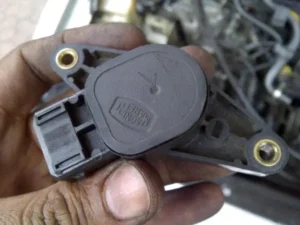The throttle position sensor (TPS) is vital to a vehicle’s fuel injection system. This sensor monitors the position of the throttle and sends data to the engine control unit to ensure optimal air-fuel mixture for efficient engine performance. A faulty TPS can cause various drivability issues and negatively impact engine power, acceleration, fuel economy, and emissions.
In this comprehensive guide, we will explore the function of the TPS, learn how to recognize common symptoms of bad throttle position sensor, understand the implications of a faulty TPS, and go through diagnosing and repairing/replacing this critical engine component.
What is a Throttle Position Sensor and What Does it Do?
The throttle position sensor is located on the throttle body of fuel-injected vehicles. It monitors the position of the throttle valve and relays this data to the vehicle’s engine control module (ECM).
The ECM uses input from the TPS to:
- Calculate the load on the engine
- Determine the appropriate air-fuel ratio
- Adjust ignition timing
- Regulate acceleration
- Control transmission shifting
- Operate other emission control components
The TPS provides critical data to maintain optimal fuel economy, engine performance, drivability, and emissions. The ECM cannot efficiently control fuel injection, spark timing, or other functions without accurate data from the TPS.
Signs and Symptoms of Bad Throttle Position Sensor
A failing or faulty TPS can cause various symptoms, including:
1. Check Engine Light
One of the first signs of a bad TPS sensor is the check engine light coming on. The ECM detects improper voltage signals from the TPS and generates an error code that turns on the check engine light.
Common trouble codes associated with a bad TPS include:
- P0120 – Throttle Position Sensor/Switch A Circuit Malfunction
- P0122 – Throttle Position Sensor/Switch A Circuit Low
- P0123 – Throttle Position Sensor/Switch A Circuit High
2. Acceleration Problems
Since the TPS sensor relays data to control acceleration, issues like hesitation, surging, lack of power, or rough acceleration can indicate TPS failure.
Without accurate data from the TPS, the ECM cannot properly calculate fuel trim or timing, resulting in acceleration problems.
3. Idling Issues
A faulty TPS sensor can disrupt idling in various ways, such as:
- Rough idling
- Surging/erratic idling
- Stalling
- High idling speed
- Engine dying when coming to a stop
The ECM requires TPS input to control bypass air control, idle air control, and idle fuel trim. Bad TPS data leads to unstable idling as the ECM struggles to regulate idle speed.
4. Gear Shifting Problems
The TPS sensor data helps optimize transmission shifting patterns. With a faulty TPS, drivers may experience:
- Delayed/hard shifting
- Rough gear changes
- Improper shifting patterns
5. Reduced Fuel Economy
A malfunctioning sensor can significantly reduce fuel economy since the TPS helps optimize air-fuel ratios for efficient combustion. The ECM may incorrectly richen or lean the mixture based on faulty TPS readings.
6. Misfiring at Higher RPMs
On some engines, a bad TPS sensor may cause misfiring or hesitation when accelerating at higher RPMs. This occurs when the ECM enriches the mixture too much based on erroneous TPS signals under heavy load.
If you experience any of these throttle position sensor symptoms, it’s advised to scan for diagnostic trouble codes and test the TPS sensor. Let’s look at how to diagnose a bad TPS.
How to Diagnose a Bad Throttle Position Sensor
Diagnosing a faulty TPS involves retrieving any diagnostic trouble codes, performing a visual inspection, testing sensor voltages, and doing a road test.
Step 1 – Retrieve Engine Codes
The first step is to retrieve any stored error codes from the ECM that caused the check engine light. This can point you towards the TPS as the culprit. Connect a code scanner and look for any P0120, or P012x codes described earlier.
Step 2 – Visual Inspection
Before testing the electrical function, visually inspect the TPS sensor and electrical connectors for:
- Damage to the sensor housing
- Loose, corroded, or damaged wiring and connectors
- Carbon buildup on sensor contacts
- Melted or frayed wires
Look for anything that could cause an open or short circuit in the TPS sensor circuit.
Step 3 – Voltage Testing
Use a digital multimeter to check the throttle position sensor’s voltage signals. This tests the sensor circuit for anomalies:
Test 1 – Key On Engine Off
- Check voltage at closed throttle – should be near 0.5 volts
Test 2 – During Acceleration
- With the engine running, quickly press and release pedal
- Voltage should smoothly sweep from low to high
Test 3 – Snap Throttle Test
- Quickly press pedal to wide open and release
- Voltage should go from low to high immediately
Compare voltage readings to specs in a repair manual. Erratic voltages point to a bad TPS sensor.
Step 4 – Road Test
Finally, do a road test for symptoms like hesitation, surging, or lack of power. Have someone monitor voltage signals during the test, looking for:
- Voltage that fails to reach extremes at WOT
- Slow/sluggish voltage response
- Erratic voltage fluctuations
This confirms if symptoms relate to faulty or out-of-spec TPS voltage signals.
Following these diagnosis steps will help isolate a bad TPS sensor from other possibilities before replacing it.
Consequences of Driving with a Bad TPS Sensor
While your vehicle may continue to operate with a faulty TPS sensor, it can have several implications:
- Reduced engine performance and drivability
- Increased emissions from improper fuel trim
- Greatly reduced fuel efficiency
- Potential engine overheating from a lean mixture
- Misfire and hesitation when accelerating
- Eventual stalling and failure to start
- Excess fuel consumption smelling of unburnt gasoline
Prolonged driving with a malfunctioning TPS can lead to further engine computer failures and engine wear or damage. It’s best to promptly diagnose and replace a bad TPS sensor.

How to Replace a Faulty Throttle Position Sensor
Replacing a throttle position sensor is usually a straightforward process, though specific steps vary by vehicle make and model. Here is the general TPS replacement procedure:
Step 1: Disconnect the Battery
Disconnect the negative terminal of the battery before starting any work. This avoids electrical shorts and sensor damage.
Step 2: Locate the Throttle Position Sensor
The TPS is located on or near the throttle body assembly. Consult a vehicle repair manual to find its specific position.
Step 3: Disconnect Electrical Connector
Locate the wiring harness connector for the TPS sensor and disconnect it. Use care not to damage it.
Step 4: Remove Mounting Bolts
Remove the two mounting bolts securing the sensor to the throttle body. Save them for the new sensor.
Step 5: Detach Old Sensor
With bolts removed, detach the old TPS sensor from the throttle body. Note its orientation for installing the new one.
Step 6: Install New Sensor
Place the new TPS sensor in the same orientation as the old one and install the mounting bolts to secure it.
Step 7: Reconnect Electrical Plug
Plug in the wiring harness connector to the new sensor, ensuring it clicks into place securely.
Step 8: Reconnect Battery and Test
Reconnect the battery terminal. Start the engine and test acceleration for smooth operation. Clear any codes and road tests to confirm normal operation.
With these steps, you can successfully and affordably replace a faulty throttle position sensor on most vehicles in under an hour, restoring engine performance and drivability.
Can a Dirty Throttle Body Cause a Bad Throttle Position Sensor?
A dirty throttle body can potentially cause issues that mimic a bad TPS, such as rough idle, hesitation and stalled acceleration. How does this happen?
The throttle position sensor monitors the movement of the throttle valve on the throttle body. Carbon buildup and grime impede free movement of the throttle valve. The TPS then detects incorrect positioning of the “stuck” throttle valve and sends faulty data to the ECM.
This generates symptoms resembling a malfunctioning TPS. However, the root cause is the restricted throttle valve, not an electrical issue with the TPS itself.
Before replacing a TPS sensor, use throttle body cleaner to eliminate carbon deposits. If symptoms disappear, you save yourself an unnecessary sensor replacement. The key is proper diagnosis to isolate the problem.
How Much Does It Cost to Replace a Throttle Position Sensor?
Throttle position sensor replacement costs typically range from $120 to $350. The labor time is around 1-2 hours. The sensor itself ranges from $25 to $225 depending on the vehicle. Luxury and European vehicles tend to be on the higher end.
Shop around for quotes, and consider buying an aftermarket TPS sensor to save over OEM. You can also purchase a quality sensor online and provide it to your mechanic to keep costs down.
Frequently Asked Questions
Here are answers to some common questions about TPS sensor issues:
What happens if the throttle position sensor is bad?
A bad TPS sensor can cause poor engine performance, reduced power and acceleration, unstable idle, reduced fuel economy, engine stalling, and the check engine light coming on.
How do I know if my TPS is bad?
Check for trouble codes, erratic voltage signals, throttle body carbon buildup, and symptoms like surging, hesitation, hard shifting, and idle issues.
How do you diagnose a throttle position sensor?
Diagnosis involves checking for stored codes, inspecting connections, performing voltage tests during throttle sweeps, and road testing for associated drivability problems.
What is the symptom of bad throttle?
Symptoms of a bad throttle body or TPS include power loss, rough idle, engine stalling, high idle speed, acceleration hesitation, reduced fuel economy, and difficulty starting the vehicle.
Can a bad TPS cause poor acceleration?
Yes, a malfunctioning TPS sensor can lead to poor or lack of acceleration due to incorrect airflow data upsetting fuel delivery, spark timing, and engine power.
Can I still drive with a bad throttle position sensor?
You can briefly drive with a bad TPS to go a short distance to a shop. However, extended driving can risk further engine damage. Get the faulty sensor replaced as soon as you can.
Conclusion
The humble throttle position sensor plays a significant role in proper engine operation and performance. Diagnosing and replacing a bad TPS promptly preserves drivability and fuel economy and prevents further issues.
Knowing the common symptoms, diagnostic steps, and potential impacts of a faulty TPS allows smart and rapid action. With the right information and repairs, your vehicle will be back to peak performance.





